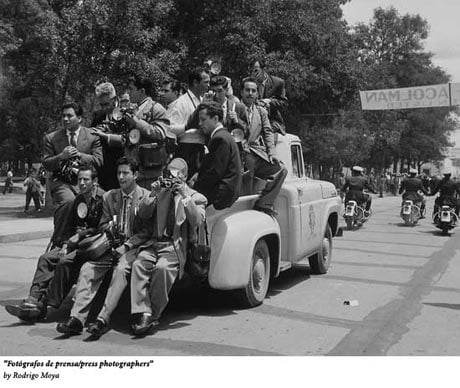Witnesses to History
In the early 1940s, a young man from a rough Mexico City neighborhood called La Candelaria de los Patos, joined the thousands of his countrymen who were traveling north to the United States to fill jobs left vacant and jobs that were created by the onset of World War II. Some worked in factories, others in the fields. Héctor García worked in railway construction.
After the war, he would make other trips to the United States—not as a migrant worker, but as a photographer. During his career, Héctor García traveled the world for Time-Life, documented every aspect of political, cultural, and social life in his own country, and proved to be equally adept at spot news, fashion shoots, and documentary photo essays. Among his images of the United States: a statue of Popeye in front of the municipal building in Crystal City, Texas—the so-called “Spinach Capital of the World”—and a haunting photograph of the Twin Towers of New York’s World Trade Center, taken in the early 1970s.
Now 82, García lives with his wife, María del Carmen—herself an accomplished photographer—in Mexico City’s Colonia Navarte, a neighborhood also known as la colonia del periodista, the journalist’s neighborhood. When I met him there last November, he repeatedly told me that “the job of a journalist is to be a witness to history.” Appropriately enough, that’s the title of the current exhibition at the Wittliff Gallery of Southwestern & Mexican Photography at Texas State University: “Testigos de la Historia / Witnesses to History.” From an archival collection of nearly 13,000 images, the Wittliff Gallery has selected 59.
“Witnesses” represents the work of 12 photographers, including Manuel Álvarez Bravo, Nacho López, Graciela Iturbide, and Rodrigo Moya, whose “Fotógrafos de prensa / Press Photographers” and “El garrotero / The Brakeman” grace the front and back covers, respectively, of this issue.
The curators have included such well-known portraits as Moya’s iconic “Melancholy Che” (Havana, Cuba, 1964) and Raúl Ortega’s “Subcomandante Marcos” (Chiapas, Mexico, 1995). Many of the other images are inherently political. Both García and Moya, for example, recorded the repression that occurred in Mexico in the wake of demonstrations by railway workers and students in 1958—a foreboding of what would happen 10 years later when a university student movement culminated in the massacre of hundreds at Mexico City’s Plaza de Tlatelolco. In October 1968, no newspaper would publish García’s courageous photograph of soldiers toting guns in the Zócalo, the main plaza, of Mexico City. Two years later, cultural historian Carlos Monsiváis chose the image for the cover of his book Días de guardar (Days to Remember), one of the first books written in Mexico about the 1968 student movement.
But few documentary photographs are as powerful as the images of street kids made by García, who himself was orphaned at an early age and spent time in a Mexico City “correctional institute.”
Not everything, of course, is about politics and social injustice. The curators have also selected images made from the serendipity of ordinary life. Collectively, however, the exhibit documents the great stories of the 20th and early 21st centuries, not only in Mexico, but throughout the Americas: migration from the country to the city; the rise of the modern mega-city, with all of its wonders and horrors; the tension between traditional culture and modernity; and the tension between the haves and have-nots.
A growing number of younger photographers now focus on the northern border, such as Eniac Martínez, who has traveled by foot following campesinos from the Mixteca region of Oaxaca to the United States. Others, such as Antonio Turok, best known for his work during the 1994 Zapatista revolt in Chiapas, continue to live and work in southern Mexico.
As you view the remarkable work of these 12 photographers, there is something important to keep in mind: They are witnesses not only to the history of Mexico and Latin America—but also to our own.
Testigos de la Historia / Witnesses to History runs through February 12. The Wittliff Gallery is located on the seventh floor of the Alkek Library of Texas State University in San Marcos.
For more information, see www.library.txstate.edu/swwc/wg or call the Gallery at 512-245-2313.

*Other photos available in print magazine only.


